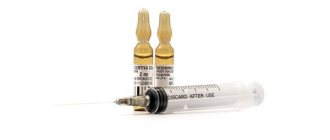The norm is considered to be a general body temperature of +36 to +37°C. A periodic decrease to +35.5°C is possible with hypotension, hypothermia and some infections. Usually this condition normalizes on its own over time. But there are situations where hypothermia is very dangerous.
Nervous and physical exhaustion
High physical activity, prolonged stress, lack of sleep, poor diet and strict diets often lead to a deficiency of the body’s energy resources. As a result: metabolism slows down, blood circulation slows down and the temperature drops below normal by 1-2 degrees. The pathological condition is accompanied by significant weight loss, apathy, weakness, fatigue, depressed mood or increased nervous excitability. There may be frequent headaches and decreased mental abilities. The person becomes distracted and inhibited. There is a weakened immune system and hypovitaminosis.
With physical and nervous exhaustion, body temperature steadily decreases to +35–35.5°C. The condition is accompanied by chills even in warm weather. This pathology is usually not life-threatening, but it is an alarming sign that requires urgent lifestyle changes.
Causes of low temperature
- Exacerbation of chronic diseases, for example, vegetative-vascular dystonia.
- Insufficient production of thyroid hormones – hypothyroidism.
- Pathologies of the adrenal glands.
- Pregnancy.
- Taking certain medications, especially antipyretics and vasoconstrictors.
- Low blood pressure, heart disease.
- General fatigue, poor sleep, depression, stress.
- Recent viral or bacterial infections.
- Anemia.
- Fasting and strict diets that caused a lack of vitamins and nutrients.
- Sepsis.
- Skin diseases affecting large areas of the body.
- Poisoning with alcohol and drugs.
- Presence of HIV infection.
There are also external reasons for a decrease in body temperature - a long stay in water, in the wind, in a cold room with drafts, staying in the same position.
Post-viral syndrome
In this case, the body temperature usually stays around +35.5°C or +35°C for several days. In the fight against infections, the body spends a lot of internal resources, suffers from the consequences of intoxication and microbial aggression, which is why many functions, including thermoregulation, are disrupted. The early period of recovery is often accompanied by a decrease in temperature. The condition is accompanied by other symptoms: physical weakness, bad mood, drowsiness, decreased concentration. Shortness of breath may occur, worsening with exertion and stress. Children, adolescents, and people with chronic vascular and central nervous system diseases are susceptible to pathology.
How can hypothermia manifest?
It is necessary to measure your temperature if you notice the following symptoms:
- increased fatigue and drowsiness, which is difficult to cope with on your own;
- feeling overwhelmed;
- nervousness, irritability;
- you find it difficult to concentrate.
Children with low body temperature experience tearfulness, lethargy, moodiness, and lack of appetite.
Do not forget that the objectivity of the thermometer readings largely depends on the time of day, age and even the location of measurement. For example, in the morning, after sleep and long rest, body temperature is always slightly lower than usual.
Low blood glucose
Hypoglycemia due to prolonged hunger and excess insulin provokes energy starvation of the brain, slows blood circulation and metabolism. As a result of glucose deficiency, physical weakness develops, dizziness, and attacks of hunger. With a prolonged lack of sugar in the blood, coordination of movements is impaired, asthenia sets in, the body breaks out in cold sweat, and body temperature drops to +35°C. In the absence of outside help to the body, fainting and hypoglycemic coma are possible. People of any age are susceptible to pathology; insulin-dependent patients suffer more often than others.
Treatment
Help before diagnosis
If the body temperature is more than 32°, you can get by with passive warming. The person is wrapped in heated blankets or placed in a bath with warm water and given hot tea. With prolonged hypothermia and satisfactory condition during the convalescence period, specific treatment is not required - sleep 8-10 hours a day, increased calorie intake, and adequate rest are recommended. If the reasons for the detected low temperature are unclear, consult a doctor.
First aid for hypothermia
Conservative therapy
At critically low temperatures, active warming is effective: heat fans and heating pads, inhalation of warm humidified oxygen and intravenous infusion of heated solutions. In emergency situations, warm lavage and extracorporeal blood purification methods are used. For etiotropic and pathogenetic treatment of diseases accompanied by a drop in human body temperature below 36 degrees, the following are prescribed:
- Vitamins
. With general exhaustion of the body, B vitamins are indicated, which enhance neuromuscular transmission and improve the trophism of nervous tissue. Alpha tocopherol is used as a powerful antioxidant. For severe weakness, glucose solutions with vitamin C are administered. - Hormones
. Replacement therapy with levothyroxine allows you to accelerate the processes of metabolism and thermogenesis, and restore normal body temperature. In case of Addison's disease, cortisol preparations are necessary; in case of a lack of mineralocorticoids, aldosterone is additionally administered. - Cardiotropic drugs
. Medicines stimulate cardiac activity in shock and other critical conditions, normalize cardiac output and increase blood pressure. The drugs of choice for emergency care are solutions of adrenaline or dobutamine; in hospital therapy is supplemented with glycosides. - Antidepressants
. The medications are serotonin receptor agonists and improve neural connections between different parts of the brain. Temperature normalization occurs due to stimulation of the hypothalamic center and increased contractile thermogenesis. - Antibiotics
. Hypothermia often masks the manifestations of a severe bacterial infection, so broad-spectrum antibiotics are indicated for very low body temperatures. Medicines are administered intravenously until temperature values normalize and general condition improves. - Antidotes
. For acute signs of intoxication, universal drugs are used that bind or destroy various toxic substances. In cases of heavy metal poisoning and drug overdose, unithiol is effective.
Help with hypothermia
Immediate measures: exposure to heat, elimination of hunger, neutralization of toxins. A person with hypothermia is advised to drink hot tea, take a bath, and wrap himself in a thick blanket. In critical conditions, hospitalization is required.
The exact causes of the pathological symptom are determined by the therapist or doctors of other profiles. Diagnostics includes biochemical and hormonal blood tests, ECG, ultrasound of internal organs, computed tomography or MRI of the spine and brain. A complete medical examination helps to identify the most unexpected causes of low temperature.
Drug therapy depends on the established diagnosis. These can be antibiotics, immunomodulators, antidepressants, nootropics. To consolidate the results of treatment, the doctor usually recommends purchasing vitamin and mineral complexes.
Prevention of low body temperature
- If you have chronic diseases, carefully monitor your well-being. Visit your doctor regularly and follow all his instructions.
- Strengthen your immune system. Eat a balanced diet and take a course of vitamins at least twice a year – in autumn and spring.
- When relaxing on the sea or river, do not stay in the water for too long. When you go ashore, immediately dry yourself with a towel. Small children should be changed into dry clothes immediately.
- Do not create drafts in the apartment. 10-15 minutes for ventilation is enough.
- Always dress appropriately for the weather. Don't be outside in wet clothes.
- If, due to circumstances, you are forced to spend a lot of time in the same position, give yourself five-minute exercise sessions at least once every two hours.
If the thermometer is above 36.6 degrees C
Situations with low temperatures in clinical practice are much less common than indicators above 36.6 degrees C. Many modern people have come to regard moderately elevated indicators (low-grade fever) as a necessary condition for the body’s fight against infection. That is, if the temperature does not exceed 380, today there is no rush to bring it down, realizing that as the degrees rise, the body’s protective functions improve.
Still, you should not sit idly by at elevated (above 37.1) temperatures. This is a signal about a developing inflammatory process, which means that the body needs to help cope with it:
- if there are obvious signs of a cold, provide plenty of warm drinks, rinse the throat and nose with a saline solution, and ventilate the patient’s room;
- if you have acute pain (head, stomach, ears), consult a doctor;
- If there are signs of intoxication (nausea, vomiting, diarrhea), call an ambulance.
In a situation where the temperature remains at a low-grade level for weeks or months, it is also necessary to see a doctor and undergo an examination, since tuberculosis, endocrine or tumor diseases may be hidden behind this symptom.
If the temperature is above 36.6 degrees, but does not exceed 37.10 C, there is no reason to worry.
Internal hemorrhage
Internal bleeding may be caused by damage to blood vessels. In turn, it can be caused by the progression of peptic ulcer disease, tumor growth, disturbances in the functioning of the cardiovascular system, and increased fragility of the vascular walls.
Also, internal bleeding can be caused by problems in the endocrine system and diseases associated with metabolism.
The chronic form of internal hemorrhage can occur without significant symptoms.
A feeling of fatigue, characteristic diseases that may be indicated by the patient's medical history, pale skin and drowsiness may be signs of hemorrhage. In case of injury or bruises of internal organs, hypothermia indicates the need for specialist help. If the patient loses consciousness, you should not hesitate under any circumstances; urgent hospitalization is necessary.
Briefly about the causes of hypothermia
To make it easier to determine the source that caused the temperature to drop below normal, you need to pay attention to the accompanying symptoms. Having decided on the cause, you can begin therapeutic actions or seek the help of specialists.
In most cases, a decrease in temperature does not pose a significant danger, but it does cause inconvenience and discomfort.
| № | Associated symptoms. | Probable cause. | Help and treatment. |
| 1 | Shortness of breath, low blood pressure, tiredness and fatigue. Frequent dizziness, heart rhythm disturbances. Dry skin, brittle hair and nails, changes in taste and smell. | Low hemoglobin | Take a blood test for hemoglobin levels, normalize your diet, and start taking iron supplements. |
| 2 | Lethargy, cold sweat, significant decrease in blood pressure. Pale skin, nausea, slowed psychomotor skills. Provoking factors: trauma, blunt force trauma, bruise of internal organs, acute and chronic diseases and conditions that can cause hemorrhage. | Internal bleeding | Urgent assistance from a specialist is required. The patient should take a horizontal position, apply cold to the site of possible damage, and give access to fresh air. |
| 3 | Significant decrease in body temperature, weakness. Difficulty breathing, fainting. Dizziness, nausea and vomiting during pregnancy. | Hormonal changes during pregnancy | The patient needs rest, offer warm drinks, clothing; When the temperature drops to a critical value, the help of a specialist is required. |
| 4 | Fainting, pain in the eyes, severe headache. Loss of consciousness, feeling of lack of oxygen. Weakness, high heart rate, tachycardia. | Vascular dystonia | Help the patient take a horizontal position, offer water, loosen the collar, facilitate the flow of oxygen, help calm down in a state of panic. |
| 5 | Dry mouth, constant thirst. Peeling skin, lack of strength, dizziness. Frequent urination, significant changes in body weight. | Diabetes | Depending on the type of diabetes: taking special medications, following dietary recommendations. |
| 6 | Sudden mood swings, fatigue and drowsiness. High fatigue, menstrual irregularities in women. Alopecia, migraine, memory impairment. | Adrenal diseases | Get tested for hormones, get rid of the source of stress, take appropriate hormonal medications to normalize the body’s functioning. |
| 7 | Constant feeling of fatigue, pale skin. Nervous symptoms, headaches. Weakness and lethargy, low appetite, drowsiness. | Asthenia | Identification of the cause of the condition, symptomatic treatment. |
| 8 | Cough, headache, general weakness. Dizziness, decreased psychomotor reactions, runny nose. | ARVI | Taking antiviral drugs, ensuring rest, sufficient fluids, warmth and a balanced light diet. |
| 9 | Nausea, vomiting, bowel movements, loss of strength. Lethargy, pain in the stomach. Provoking factors: drug overdose, consumption of stale or suspicious food, intoxication with chemicals. | Poisoning | Taking adsorbent drugs, drinking plenty of fluids, helping to restore water-salt balance, gastric lavage in severe cases. |
| 10 | Pale skin, chills, runny nose. Redness of the eyes, slow reactions, tremors. | Hypothermia | Gradual warming; in case of particularly severe hypothermia, the help of a specialist is required. |
If the temperature drops slightly, you can cope with the condition on your own. To do this, you need to determine the cause of hypothermia, and then begin symptomatic treatment. If an adult has a temperature of 34, there is no need to do anything on your own, call emergency help immediately. You cannot hesitate to contact specialists, since a change in the state of the body indicates an acute disturbance in its functioning.
What not to do at high temperatures
You should react to an elevated temperature without panic, but with special care.
It is not recommended to bring it down in the first minutes after the increase; you need to let the body cope with the temperature on its own. At this time, the body’s defenses are mobilized and pathogens of various diseases die. But even when lowering the temperature, you should not strive for 36.6. In the first days of illness, this is unlikely to be achieved. Rubbing, especially with vinegar or alcohol solutions, is not recommended. However, this practice still exists at home. If a patient with a high fever is pale and his limbs are cold to the touch (so-called white hyperthermia), then any rubbing is contraindicated for him and, in addition to antipyretics, antispasmodics are recommended. The fact is that cold extremities are caused by vasospasm. And in this case, cold rubbing with vinegar or alcohol-containing liquids can only worsen the situation with the blood vessels.
Wiping with vinegar is not indicated for adults and children with respiratory manifestations of the disease or chronic pathologies of the respiratory system. Vapors can worsen the patient's condition and affect the breathing process. Also, intolerance to vinegar or alcohol, as well as the presence of damage and irritation of the skin, are contraindications to rubbing.
At high temperatures, it is not recommended to eat rich, fatty foods and sugar. An increase in glucose levels in the body reduces the number of white blood cells, which are responsible for destroying infected cells. Which can harm the process of fighting bacteria and viruses. And fatty foods create additional stress on digestion and the body devotes some of its energy to this process, instead of fighting the enemy.
Speaking about drinking liquid at a fever, it should be noted that hot drinking is strictly contraindicated! Especially coffee. Caffeine causes dehydration. A hot drink warms up the body even more. Only warm fruit drinks and herbal teas.








